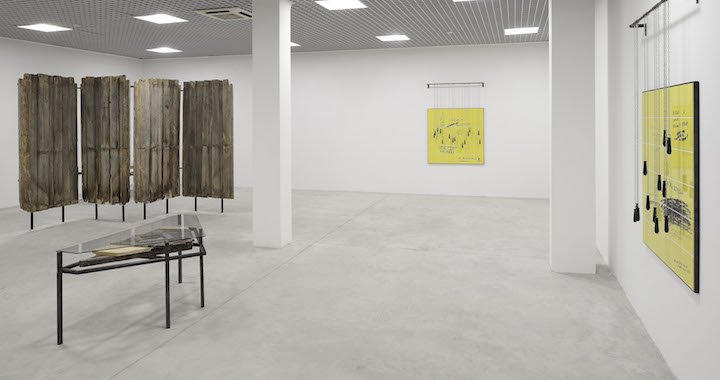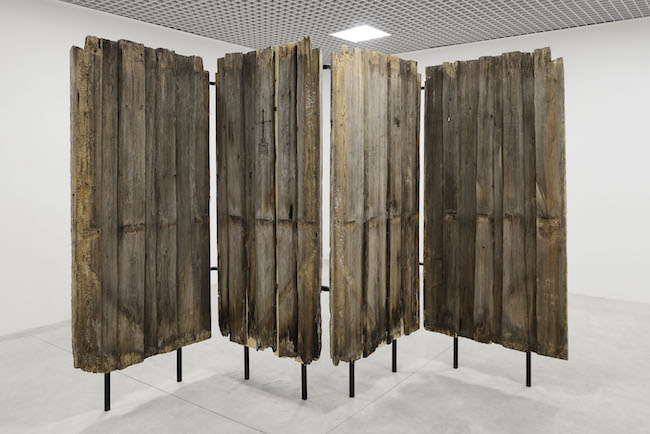
When opposites attract
An express-interview with Estonian artist Jaanus Samma
05/11/2018
The last several years have been quite successful for a certain group of Baltic artists from the 1980s generation – they have conquered the Western art world by demonstrating that they (and the region as a whole) can be quite competitive in terms of of contemporary creativity. One of these young artists is Jaanus Samma from Estonia, who gained international recognition for his focus on queer themes and interventionist methods at the Estonian Pavilion at the 56th Venice Biennale.
Jaanus Samma was born in 1982 in Tallinn, and has studied at the Estonian Academy of Arts, the École superieure Estienne des arts et industries graphiques, and at Université Paris 8 Saint-Denis in France. His works include installations, photographs, and videos that centre around the study of urban space. Lately, his works have been investigating the representation of gender-isms, especially male sexuality. Since 2009 he has spent time in six different artist residencies, and in 2013 he received Estonia’s premier national art award – the Köler Prize. Three years later he received the Kristjan Raud Art Prize, and since then has continued to organise several important exhibitions. The latest of these is Outhouse by the Church, on view at the Nomas Foundation in Rome until December 14.
The exhibition, curated by Italian art critic and curator Eugenio Viole, is a project that focuses on public toilets. The subject spins around the perception of public spaces and the meaning of ‘toilet’ – not in a literal way, but as a meeting point for various social and cultural contexts. The title piece of the exhibition is an installation made of remnants of an old wooden outhouse used almost a century ago. In contrast to this, Jaanus Samma also draws attention to the public toilets of Flaminio Station in Rome, which was also the study subject for his 2016-2018 series Flaminio Station (conceived after a residency at Nomas Foundation in 2016). Different social experiences touch upon the topic of casual needs, blending the notion of right and wrong. In the following express-interview for Arterritory.com, Jaanus Samma explains the birth of his interest in these sensitive topics.

Exhibition view. Photo: Roberto Apa
In your creative practice, you often allude to issues pertaining to the social sphere. These may be queer topics, questions that touch upon history from the aspect of collective thinking, or – as in your latest project, Outhouse by the Church – a representation of the diversity found in public toilets. Do you think that the visual arts are somehow obliged to reflect on social matters?
I don't think that the visual artists are obliged to reflect upon social matters, but I think that most of them are doing it anyway, though maybe indirectly…
I feel an obligation to be honest, and through my art, to talk about things that I know and care about.
I point out knowledge because I am touched by many things, but I feel uneasy working with a topic about which I don't understand all of its layers and complexities.

Works from Flaminio Station series, 2017-2018. Photo: Roberto Apa
What, in your opinion, is provocative art, and do you consider yourself a provocative artist?
I definitely don't consider myself a provocative artist. I am not sure what a provocative artist is – perhaps someone whose main purpose is to provoke the audience, but this has never been my main goal. I do admit, however, that sometimes I have found it necessary to also show something disturbing.
But I think that one can never actually know what will provoke people. Sometimes you think that, finally, you have really pushed some boundaries – but then nobody cares; other times, people are provoked by something that you would never have thought of as being anything special in this sense.

Flaminio Station, 2017. Photo: Roberto Apa

Outhouse by the Church, 1916, 2018. Photo: Roberto Apa
As I already mentioned, in your latest project on view at the Nomas Foundation in Rome, you focus on public toilets. What’s the story behind this exhibition, and – if I may ask – your interest in this topic?
I began to be interested in public toilets for various reasons. Many of my works already go in this direction – like the collection of sweaters on which I used graffiti as a pattern. Some of those writings I had found scribbled in toilets. But also, my projects about gay history. As we know, in many countries, public toilets used to be important meeting places for gay men. But what I found fascinating was that all this action took place in the city centre, under everyone’s eyes. As if the public toilet was a place without any rules, a non-place where everything is allowed.
Outhouse by the Church focuses mainly on two case studies: the public toilet at Flaminio Station in Rome; and the title piece, Outhouse by the Church, which is a historical wooden outhouse from Estonia.
Flaminio Station is one of the last unmodernised public toilets in Rome, and a popular cruising site, which is quite rare considering that these cruising areas have mostly disappeared due to the rise of popular dating apps.
The work Outhouse by the Church is an installation that consists of deconstructed fragments of a historical wooden outhouse that was originally located next to St. Michael’s Church in the village of Kodavere in eastern Estonia. The remarkable feature of the outhouse is the well-preserved historical graffiti that dates back from as early as the 1920s. Over the years, people have been adding their scribbles – from simple name tags and visit dates to village slander and even bawdy poems. Since the outhouse was in a very bad state, I asked for permission to transport the entire thing into my studio, where I then contacted the conservators who restored it. We also took infrared pictures of it, since some of the texts were no longer visible to the naked eye.
It was quite an exciting process for me.

Study of a Toilet, 2016-2018. Photo: Roberto Apa
What is the most interesting, thrilling part of this project – the research that led to this result, or the result itself?
That is an interesting question! The research was very interesting: to work with conservators and historians, to view the documents in the archives, and also to interview the locals who lived in the area and who still remember the people who had written their names in the toilet almost 90 years ago. About the result, I think that the installation itself is not the only result. I consider the result being the knowledge that was created during this process of bringing together all of these people. In the exhibition, one can't see the whole process, but I will have the exhibition catalogue, which I think is a more appropriate place to explain the processes behind the work, ready by the end of November

Collection of Toilet Pulls, 2018. Photo: Roberto Apa
We all know the legendary story about Marcel Duchamp and his Fountain (1917), which is still considered one of the masterpieces that changed the 20th-century art scene. After Duchamp, several other artists, including Maurizio Cattelan and Sherrie Levine, turned to this subject. What do you think it is that attracts people to the subject?
Duchamp's Fountain is an iconic artwork, and it will always attract people. When we talk about ‘the toilet’, then this is something with which we can all relate to. It is taboo to talk about it, but at the same time, something that we all have to think about every day. So, this dual concept is also intriguing. To make art about ‘the toilet’ adds another layer to this. A banal and dirty toilet is now on view inside a glass box; it has become expensive, and one can only touch it with white gloves – which is the exact opposite of what a toilet usually is.

Study of a Toilet Paper Roll 1, 2016. Photo: Stanislav Stepashko